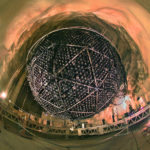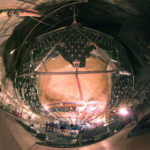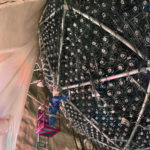The Sudbury Neutrino Observatory (SNO)
Located in a cave more than a mile underground in Canada, SNO can be thought of as a type of telescope, though it bears little resemblance to the image most people associate with that word. It consists of an 18-meters-in-diameter stainless steel geodesic sphere inside of which is an acrylic vessel filled with 1000 tons of heavy water (deuterium oxide or D2O). Attached to the sphere are 9,522 ultra-sensitive light-sensors called photomultiplier tubes. When neutrinos passing through the heavy water interact with deuterium nuclei, flashes of light, called Cerenkov radiation, are emitted. The photomultiplier tubes detect these light flashes and convert them into electronic signals that scientists can analyze for the presence of all three types of neutrinos.



